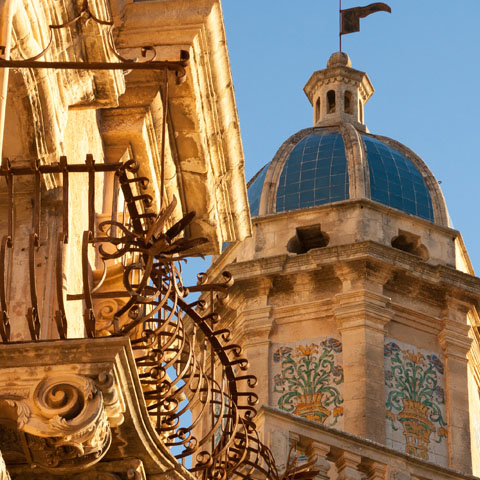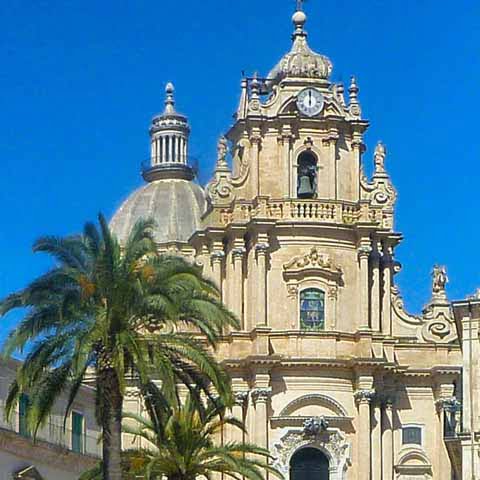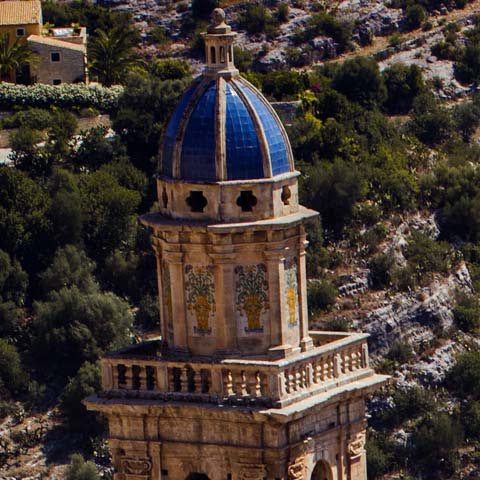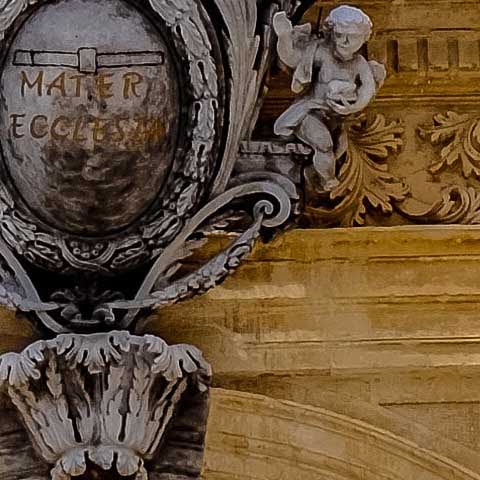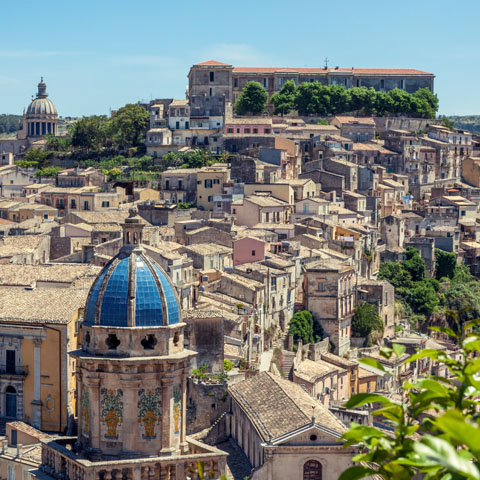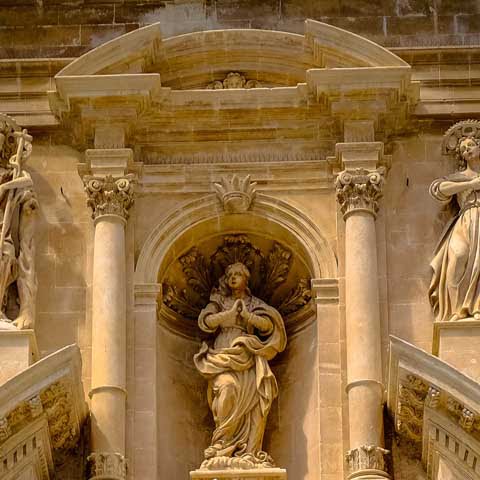Tucked away in the tranquil countryside of southeastern Sicily is the remarkable city of Ragusa, whose distinctive architecture stands out among the lush, green landscapes. Ragusa has differentiated itself from many of Italy’s top destinations by representing the old and the new, both literally and figuratively. It has thousands of years of history and stands as a testament to Baroque architecture. Today Ragusa is one city split into two distinct parts – Ragusa Superiore and Ragusa Ibla.
This separation of past and present is all due to a devastating earthquake that hit Ragusa and the rest of the surrounding area in 1693. The original city was destroyed and, as a result, had to be rebuilt. The decision was made to build a new city on the plateau above the ruins of Ragusa, which offered more stable ground. However, the local aristocracy did not want to abandon the original city. Therefore, in the years following the earthquake, two separate settlements were constructed: Ragusa Superiore, the upper area built with an ordered city layout, and Ragusa Ibla, the lower area built upon the ruins of the old city in accordance with the winding medieval layout. Today, the two towns exist as one and represent the essence of Ragusa – a city that manages to have two identities with one common history.
The timing of the reconstruction in Ragusa Ibla resulted in the churches, structures, and monuments to have a distinctly Sicilian Baroque style. Other nearby cities were similarly affected by the earthquake and rebuilt in the same manner. Ragusa (together with 7 other cities in the Val di Noto) is a recognized UNESCO World Heritage Site due to its incredible Sicilian Baroque architecture. UNESCO describes these locales as “representing the culmination and final flowering of Baroque art in Europe.”
This unique combination of past and present makes visiting Ragusa a one-of-a-kind experience. At one moment you can be exploring the bars, restaurants, and well-organized streets of the new town, and the next you can be navigating small cobblestone avenues of the old town, taking in the historic structures which line them.
Ragusa is the capital of the Sicilian province of the same name. It is home to around 75,000 people, with wonderful sightseeing, delicious cuisine, and so much more. The city is a bit remote, but intrepid travelers who venture to Ragusa will be rewarded with unbelievable sights as well as fascinating traditions and local customs unfettered by outward influence. This allegiance to history is evident in the city’s way of life, recipes, and winemaking traditions.
GEOGRAPHY & CLIMATE IN RAGUSA
Located in the southeastern portion of the island of Sicily, Ragusa is situated below the Hyblaean Mountains. The city sits atop a hill that is made of limestone and separates the Cava San Leonardo and Cava Santa Domenica valleys.
The geography of the city is almost equally as important to the city’s identity and its cultural offerings because Ragusa is known for being divided into two parts. Nicknamed the “City of Bridges” the two parts of the city – Ragusa Superiore and Ragusa Ibla – are separated by a large ravine that is crossed by three picturesque and historic bridges. These upper and lower parts of Ragusa have developed their own distinct identities, though today they are considered to be one city. The Hyblaean Plateau is known for having areas of land separated by dry stone walls, and Ragusa is certainly an example of this.
The climate of Ragusa is temperate and warm, with average summer temperatures reaching the high 80s. Summer afternoons can be dry and hot, so if visiting during this time of year, plan a break at a local café or restaurant to enjoy a cool beverage, such as a classic Sicilian granita. Precipitation occurs mainly in the winter and less in the summer. Travelers will find nearly any period of year to be a good time to enjoy Ragusa.
WHEN IN RAGUSA
Visit the Cattedrale di San Giovanni Battista in Ragusa Superiore. It is the main attraction for upper town Ragusa and features a majestic Baroque façade as well as a spectacular interior with three gold-embellished colonnades. It was rebuilt in the early 18th century by architects Giuseppe Recupero and Giovanni Arcidiacono, who oversaw the reconstruction following the earthquake.
Be sure to spend ample time exploring the old town Ragusa Ibla as well, as you are certain to fall in love with its many historic sites. One of the best ways to do so is to head to the fifteenth century Santa Maria della Scala church. The church is located on a street that connects the upper town and lower town. If you make your way down the twisting and turning stairs beneath the church, you can take in the most splendid views of the old town in all its glory. The church itself is also rather interesting; due to the 1693 earthquake, part of the church was rebuilt in the Baroque style, while the rest was left in the original Gothic style.
Perhaps the most significant historic monument in Ragusa Ibla is the stunning Cattedrale di San Giorgio, whose architecture is one of the finest expressions of the Baroque style in the world. Rebuilt in the eighteenth century atop the ruins of an ancient church that was destroyed by the earthquake, the Cattedrale di San Giorgio is known for its expansive interior with a Latin Cross layout, as well as its frescoes depicting the final events in the life of St. George. The Cathedral’s massive dome, completed in the nineteenth century, soars above the city contributing to its iconic skyline.
Visit the Giardino Ibleo, Ragusa’s historic public garden. Ideal for enjoying some time outdoors on a beautiful Sicilian day, the garden features lush greenery including palm trees and Mediterranean plants as well as a church called Chiesa dei Cappucini. The gardens are beautiful on their own, but they also offer amazing views of the surrounding valleys and canyons.
Enjoy the local cuisine – particularly the cheese and wine. Due to the heavy presence of livestock farms in the surrounding area, Ragusa is a city that takes cheese very seriously, from fresh and sweet cheeses to aged cheeses and everything in between. Truly, tasting local delicacies like provola ragusana, ricotta iblea, or caciocavallo ragusano paired with locally made preserves and bread is one of the best ways to experience the area’s flavors. As for wine, enjoy glasses of some of Sicily’s best reds such as Cerasuolo di Vittoria. Other delicious foods to enjoy in Ragusa include the characteristic scaccia (a local version of layered/stuffed focaccia bread), cavati pasta, and chocolate made in the nearby town of Modica.
Explore the history of Ragusa – from its earliest settlers to Greek and Roman times – at the Archeological Museum. Located on the first floor of the Palazzo Mediterraneo in Ragusa Superiore, the museum contains important artifacts and art pieces from throughout Ragusa’s history.
In order to truly get to know the heart of Sicily, you must travel to its historic cities and discover the unique character and culture of each. With its world-renowned architecture, breathtaking panoramas, and rich cuisine, Ragusa is a city full of charm seated at the intersection of old and new, just waiting to share its secrets with you.
Don't just see Italy, live it.
Your dream trip to Italy has never been closer
No more endlessly scrolling travel sites. Our travel experts will craft the perfect, one-of-a-kind trip just for you.

300+
DESTINATIONS
We offer more Italian destinations than any travel site. Do and see more with Trips 2 Italy.
1 (of a kind)
ITINERARIES
Because your dream trip to Italy should be designed for you, not for the masses.
100%
PEACE OF MIND
From flights and accommodations, to food and activities - we take care of every detail.
